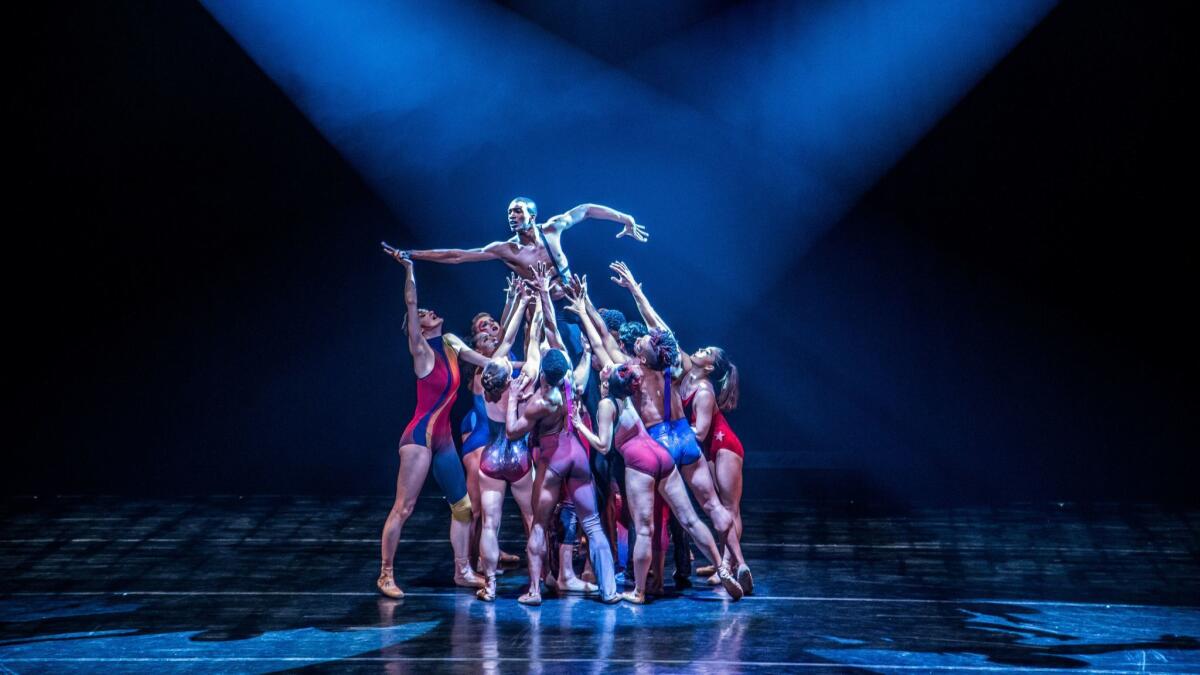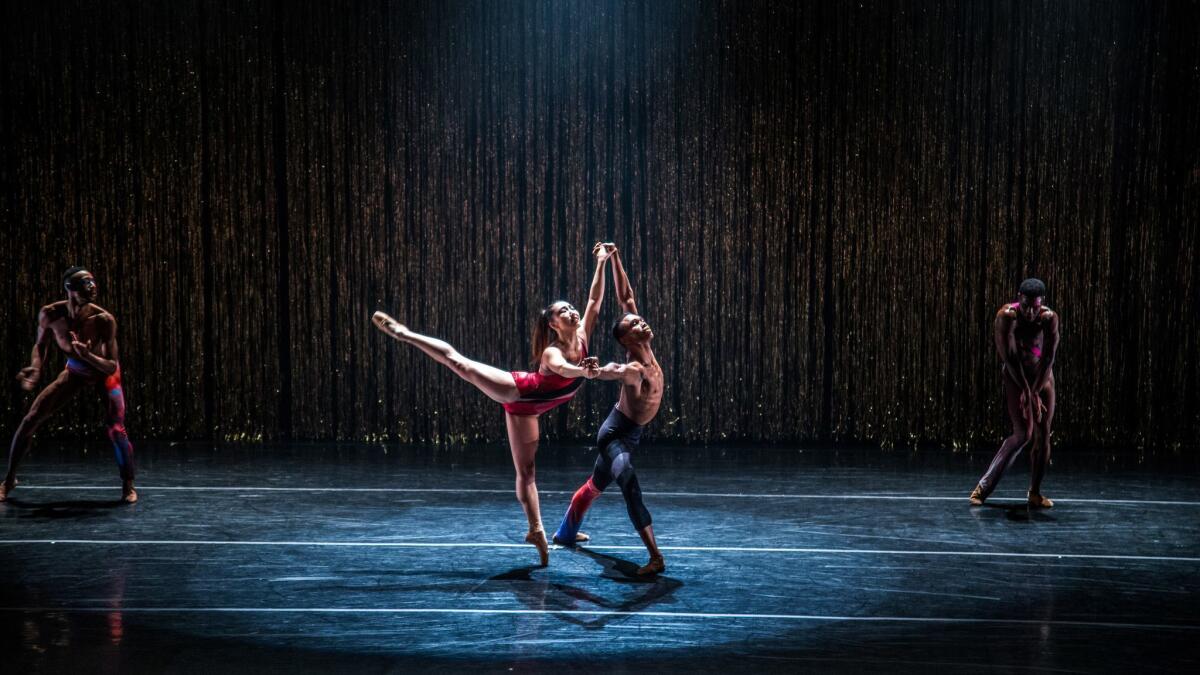David Bowie, the ballet: Complexions dancers pay tribute with ‘StarDust’
David Bowie may have had a No. 1 song with “Let’s Dance” in 1983, but let’s be honest: He wasn’t exactly known for being a dancer himself.
“There’s an awkwardness to the way he used to move,” choreographer Dwight Rhoden said, adding: “But it was cool. The way he kind of bopped around on the stage that was like nobody else.”
Rhoden, the co-founder of the New York company Complexions Contemporary Ballet, had been mulling the idea of choreographing a dance piece to the music of the chameleonic pop star when Bowie’s death in January 2016 provided the cosmic inspiration to push the project forward.
The result is “StarDust,” a tribute to Bowie that will make its West Coast premiere at the Music Center’s Dorothy Chandler Pavilion on April 20.
The 15 dancers of Complexions will explore the rhythms, personas and musical drama of nine Bowie songs including “Changes,” “Rock and Roll Suicide,” “Heroes” and “Space Oddity.”
“I wanted a journey that was kind of kaleidoscopic in a way, that really switched worlds a lot,” Rhoden said. “I wanted to make sure that I at least had a few of his popular tunes as well, because I wanted it to be relatable.”

Studded with angular glam-rock costumes designed by Christine Darch and makeup inspired by the man alternately known as Ziggy Stardust and the Thin White Duke, six or seven different dancers — men and women alike — will assume the persona of Bowie during a one-act piece that captures his androgyny and perpetual reinvention.
“My message, if there was any message, is that there’s a little Bowie in all of us,” Rhoden said. “That’s because he was so different, and individual, and again he just consistently became anew. It almost felt like every time an album came out, he was in a new place.”
The lighting design by Michael Korsch hasn’t changed since the piece debuted at Detroit Music Hall in 2016. Rhoden described it as “architectural,” sculpting the stage with lots of beams and movement.
The music is played straight off the albums. (The only non-Bowie performance is Peter Gabriel’s cover of “Heroes.”) Rhoden obtained rights to the songs but didn’t want to mess with permissions for the star’s likeness, hence the “inspired by” nature of the costumes and makeup.
Ever since Rhoden founded Complexions with the Tony-nominated actor and dancer Desmond Richardson (“Fosse”) in 1994, the company has won praise for work that’s often shapeshifting, crossing genres and mixing experimentation with entertainment — much like Bowie.
“He was so courageous and unafraid to reinvent himself over and over and over again, and that was just really compelling as a teenager and certainly into my young adult life,” Rhoden said.

The Music Center has hosted Complexions before, and Michael Solomon, vice president of presentations and education, knew an L.A. audience would connect with “StarDust.”
“I was actually very struck by a lot of the gender fluidity,” said Solomon, who saw the piece in New York last year and said he hadn’t really contemplated that aspect of Bowie before he saw it embodied by the dancers.
“I think this piece is giving voice and vision to groups of people that may, once again, feel under attack,” he added. “I think because feelings are so strong in California about what’s happening in this country as a whole, a piece like this resonates with people who feel like they are maybe part of a resistance movement.”
Bowie’s profile in popular culture has become only more pronounced since his death at age 69. The Brooklyn Museum is celebrating his career — and regular regeneration — with the exhibit “David Bowie Is,” which features dozens of costumes and handwritten lyrics among its treasures. A statue of the singer was unveiled last month in the English town of Aylesbury.
There’s also the Bowie House, a superfan’s Palm Springs home open to the public, filled with artwork and concert posters, and — for better or for worse — symphonies in Omaha and Jacksonville, Fla., recently performed programs of Bowie songs.
“His music is timeless,” Rhoden said. “It will be the kind of music that people listen to and really recognize a certain time in the world or in your life. I think he chronicled the world we live in, really.”
And for Rhoden, of course, so much of the music screams “dance.”
“At no point when I was creating this work did I find it difficult to come up with movement,” he said. “It was one of the most fluid and easy creative processes that I’ve had in a long time. It is so rhythmically dense, there’s so much imagery in the lyrics, there’s so many personas and characters and colors to his personality that it just lends itself to a performance of some kind. And I’m not done. I want more.”
It almost felt like every time an album came out, he was in a new place.
— Complexions co-founder Dwight Rhoden on the continual reinvention of David Bowie
Rhoden plans to write a second and possibly third act to make his tribute into a full evening. For now, the upcoming Music Center evening will pair “StarDust” with two other Rhoden-choreographed pieces: “Gutter Glitter,” which is scored with electronica, and “Bach 25,” a contemporary approach to the classical composer.
The full program highlights how well-matched Complexions is to the genre-hopping, categorization-defying Bowie.
“The dancers are classically trained, but we perform everything from contemporary work to the most neoclassical work,” Rhoden said. “And we’re not afraid to entertain you.”
At a time when cultural diversity has become a larger part of the arts and entertainment conversation, Solomon emphasized the values on which Complexions was founded.
“That has been part of the DNA of the company from Day 1, long before words like ‘diversity’ and ‘inclusion’ were part of our current vocabulary,” he said. “I like seeing that represented on the stage. You can see these incredibly beautiful and graceful dancers that look like people like us in California.”
Rhoden, who never met Bowie, said “StarDust” could almost be described as a rock opera.
“Sometimes dance gets the reputation of, you know, it has to be deep, dark and brooding,” he said. “Sometimes it’s just nice to have a great piece of music and have some fun.”
MORE DANCE: Spring shows not to miss »
See all of our latest arts news and reviews at latimes.com/arts.
ALSO
How do you link classical Indian dance to American tap? Four women show how
Meet the theater illusionists conjuring a red rainstorm inside Disney Hall
The childhood work of Ed Ruscha, Catherine Opie and other famous artists
The biggest entertainment stories
Get our big stories about Hollywood, film, television, music, arts, culture and more right in your inbox as soon as they publish.
You may occasionally receive promotional content from the Los Angeles Times.







